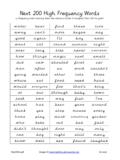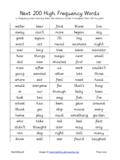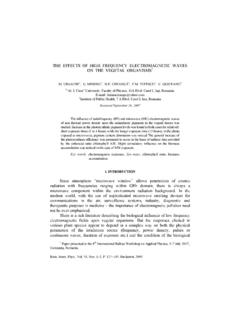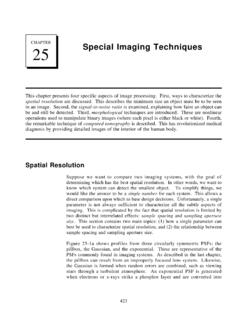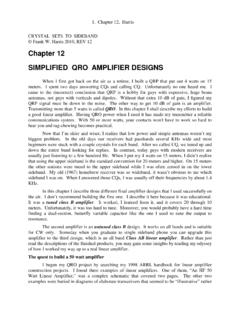Transcription of The Scientist and Engineer's Guide to Digital Signal ...
1 CHAPTER. Audio processing 22. Audio processing covers many diverse fields, all involved in presenting sound to human listeners. Three areas are prominent: (1) high fidelity music reproduction, such as in audio compact discs, (2) voice telecommunications, another name for telephone networks, and (3) synthetic speech, where computers generate and recognize human voice patterns. While these applications have different goals and problems, they are linked by a common umpire: the human ear. Digital Signal processing has produced revolutionary changes in these and other areas of audio processing .
2 Human Hearing The human ear is an exceedingly complex organ. To make matters even more difficult, the information from two ears is combined in a perplexing neural network, the human brain. Keep in mind that the following is only a brief overview; there are many subtle effects and poorly understood phenomena related to human hearing. Figure 22-1 illustrates the major structures and processes that comprise the human ear. The outer ear is composed of two parts, the visible flap of skin and cartilage attached to the side of the head, and the ear canal, a tube about cm in diameter extending about 3 cm into the head.
3 These structures direct environmental sounds to the sensitive middle and inner ear organs located safely inside of the skull bones. Stretched across the end of the ear canal is a thin sheet of tissue called the tympanic membrane or ear drum. Sound waves striking the tympanic membrane cause it to vibrate. The middle ear is a set of small bones that transfer this vibration to the cochlea (inner ear) where it is converted to neural impulses. The cochlea is a liquid filled tube roughly 2 mm in diameter and 3 cm in length. Although shown straight in Fig. 22-1, the cochlea is curled up and looks like a small snail shell.
4 In fact, cochlea is derived from the Greek word for snail. 351. 352 The Scientist and Engineer's Guide to Digital Signal processing When a sound wave tries to pass from air into liquid, only a small fraction of the sound is transmitted through the interface, while the remainder of the energy is reflected. This is because air has a low mechanical impedance (low acoustic pressure and high particle velocity resulting from low density and high compressibility), while liquid has a high mechanical impedance. In less technical terms, it requires more effort to wave your hand in water than it does to wave it in air.
5 This difference in mechanical impedance results in most of the sound being reflected at an air/liquid interface. The middle ear is an impedance matching network that increases the fraction of sound energy entering the liquid of the inner ear. For example, fish do not have an ear drum or middle ear, because they have no need to hear in air. Most of the impedance conversion results from the difference in area between the ear drum (receiving sound from the air) and the oval window (transmitting sound into the liquid, see Fig. 22-1). The ear drum has an area of about 60.
6 ( mm) 2, while the oval window has an area of roughly 4 ( mm) 2. Since pressure is equal to force divided by area, this difference in area increases the sound wave pressure by about 15 times. Contained within the cochlea is the basilar membrane, the supporting structure for about 12,000 sensory cells forming the cochlear nerve. The basilar membrane is stiffest near the oval window, and becomes more flexible toward the opposite end, allowing it to act as a frequency spectrum analyzer. When exposed to a high frequency Signal , the basilar membrane resonates where it is stiff, resulting in the excitation of nerve cells close to the oval window.
7 Likewise, low frequency sounds excite nerve cells at the far end of the basilar membrane. This makes specific fibers in the cochlear nerve respond to specific frequencies. This organization is called the place principle, and is preserved throughout the auditory pathway into the brain. Another information encoding scheme is also used in human hearing, called the volley principle. Nerve cells transmit information by generating brief electrical pulses called action potentials. A nerve cell on the basilar membrane can encode audio information by producing an action potential in response to each cycle of the vibration.
8 For example, a 200 hertz sound wave can be represented by a neuron producing 200 action potentials per second. However, this only works at frequencies below about 500 hertz, the maximum rate that neurons can produce action potentials. The human ear overcomes this problem by allowing several nerve cells to take turns performing this single task. For example, a 3000 hertz tone might be represented by ten nerve cells alternately firing at 300 times per second. This extends the range of the volley principle to about 4 kHz, above which the place principle is exclusively used.
9 Table 22-1 shows the relationship between sound intensity and perceived loudness. It is common to express sound intensity on a logarithmic scale, called decibel SPL (Sound Power Level). On this scale, 0 dB SPL is a sound wave power of 10-16 watts/cm 2 , about the weakest sound detectable by the human ear. Normal speech is at about 60 dB SPL, while painful damage to the ear occurs at about 140 dB SPL. Chapter 22- Audio processing 353. outer ear tympanic membrane ear (ear drum). canal oval window cochlea sound waves basilar sound in liquid membrane waves in air high medium low frequency frequency frequency middle detection detection detection ear bones FIGURE 22-1.
10 Functional diagram of the human ear. The outer ear collects sound waves from the environment and channels them to the tympanic membrane (ear drum), a thin sheet of tissue that vibrates in synchronization with the air waveform. The middle ear bones (hammer, anvil and stirrup) transmit these vibrations to the oval window, a flexible membrane in the fluid filled cochlea. Contained within the cochlea is the basilar membrane, the supporting structure for about 12,000 nerve cells that form the cochlear nerve. Due to the varying stiffness of the basilar membrane, each nerve cell only responses to a narrow range of audio frequencies, making the ear a frequency spectrum analyzer.










